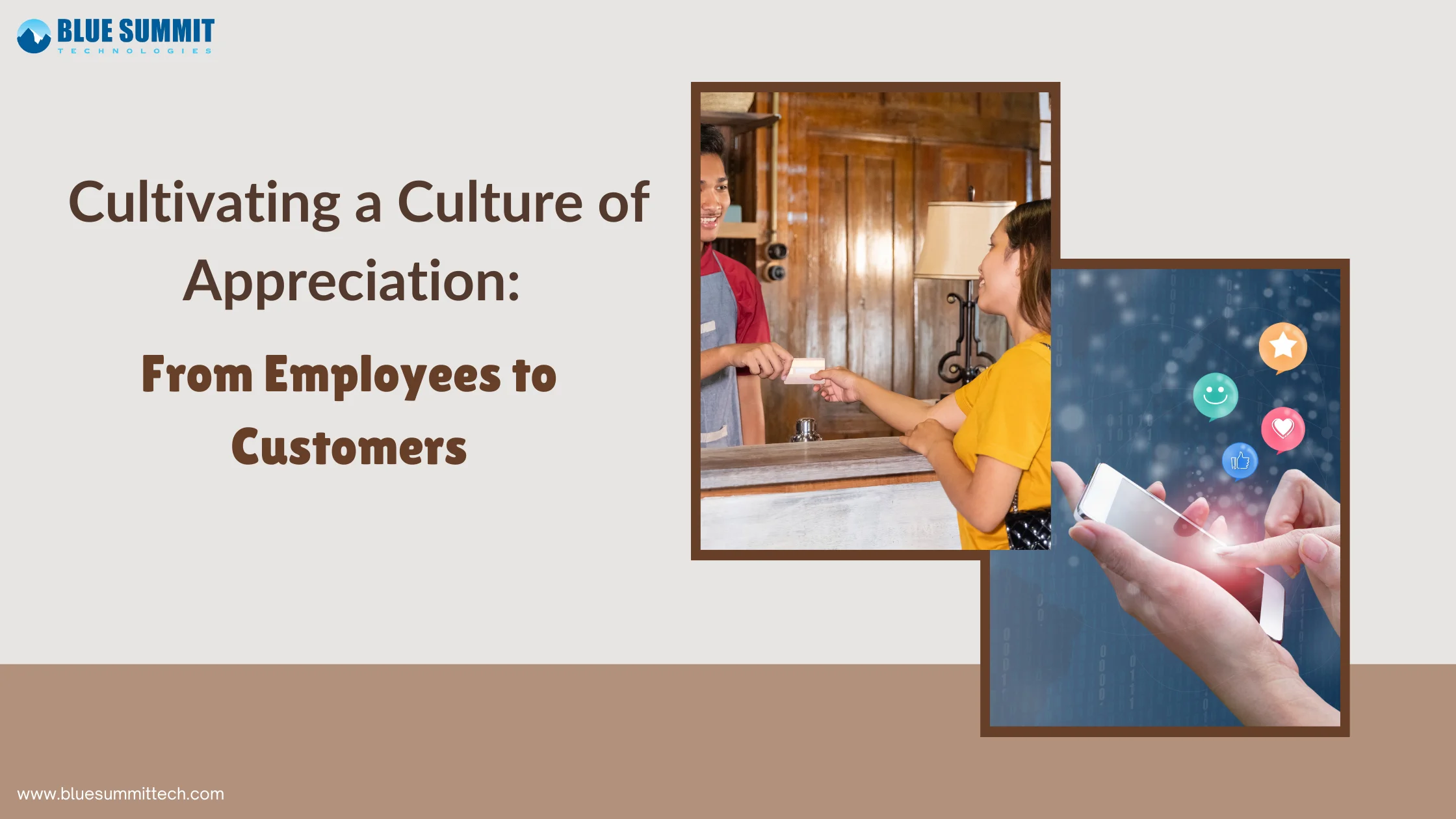
Posted on Wednesday, Aug 07th, 2024
Creating a Culture of Appreciation: Enhancing Work and Customer Loyalty
The need to feel valued, recognized, and appreciated is universal in Western culture. This desire extends beyond our personal lives and permeates the workplace. According to Great Place To Work’s 2023 discretionary effort study, 37% of respondents stated that more recognition at work “would encourage them to produce better work more often.” Furthermore, employees who consistently feel recognized are 2.2 times more likely to innovate and introduce new ideas and twice as likely to say that colleagues go above and beyond. This translates to working harder, smarter, and happier—a significant return on investment (ROI).
Similarly, customer appreciation fosters loyalty, engagement, and company growth. A Forrester survey involving 85,000 consumers revealed that the top three emotions that “inspire or discourage loyalty” are feeling valued, appreciated, and respected. While we can all agree on the importance of appreciation, how it is demonstrated is crucial. Appreciation should not be a one-time event. Annual Christmas parties or sporadic customer appreciation posts on Facebook are not sufficient. To truly benefit from appreciation within your organization, it must be woven into the fabric of the company culture.
Building a Culture of Appreciation
A culture of appreciation is about consistency. While significant events like anniversaries, birthdays, and holidays are excellent opportunities to recognize and appreciate employees and customers, smaller, regular acts of appreciation throughout the year are essential.Employee Appreciation and Recognition
It is crucial to understand the distinction between appreciation and recognition. Appreciating an employee means acknowledging their value as a person within the organization, whereas recognition pertains to their performance and effort. Both aspects should be considered when planning acts of gratitude.1. Discover What’s Meaningful to Them
Every individual has different preferences for how they wish to be appreciated. Therefore, it is essential to ask employees about their preferences. Some might appreciate food, others a handwritten note, or a personalized gift. There are numerous simple yet effective ways to show appreciation.2. Create More Opportunities for Recognition
It’s impossible to see everything that happens within an organization. To ensure that everyone’s efforts are recognized, solicit nominations from the entire team. Posting these shout-outs on an office bulletin board or internal team email can ensure everyone sees and appreciates their colleagues’ contributions.3. Be Specific
Generic comments can seem insincere. Instead, be specific about what the employee did that deserves recognition. Did they put in extra effort for a presentation? Are they consistently punctual for team calls? Specificity makes the recognition more genuine and meaningful.4. Timely Recognition
Recognizing an employee's efforts promptly has a more significant impact than delayed acknowledgment. If an employee did an excellent job on a presentation, recognize their effort as soon as possible rather than a month later.5. Align with the Bigger Vision
During team meetings, highlight how employees’ contributions align with the organization’s mission. Recognizing their role in the bigger picture not only shows appreciation but also reinforces their sense of purpose within the organization. Additionally, investing in their professional growth by offering to pay for a training course or industry conference can be a powerful form of appreciation.Customer Appreciation
According to a study by the Rockefeller Corporation, 82% of customers will stop doing business with a company if they feel undervalued. Therefore, creating a culture of customer appreciation is vital for retaining customers and fostering loyalty.1. Personalize Their Experience
Personal touches can significantly enhance customer appreciation. A handwritten thank-you note is meaningful, but personalizing the customer experience can go even further. Determine how they prefer to be contacted—whether via email or phone—and tailor marketing campaigns to their unique preferences.2. Follow Up
After a service or purchase, check in with customers to ensure they are satisfied. Proactively addressing questions or issues before customers become frustrated shows that you value and respect them.3. Create Loyalty Programs
Loyalty programs, such as Starbucks’ Rewards or REI’s co-op membership, where customers earn points for purchases or receive discounts for loyalty milestones, can express how much their business means to you and encourage continued patronage.4. Offer Perks or Gifts (Especially When Something Goes Wrong)
Customers appreciate perks on their birthdays, holidays, or to celebrate significant purchases. However, providing gifts like a free product, gift card, or discount is essential when there’s a problem. These gestures can help rectify the inconvenience and demonstrate your commitment to customer satisfaction.Infusing Appreciation into Organizational Culture
Incorporating appreciation and recognition into your organization is not merely a pleasant gesture—it is a strategic move that yields tangible results. Improved employee effort and innovation, stronger relationships, and enhanced loyalty are just a few benefits. Whether acknowledging an employee’s hard work or sending a personalized note to a customer, every interaction should be a testament to your appreciation and respect for them. This approach should be maintained not just periodically but consistently throughout the year.Implementing a Sustainable Appreciation Strategy
To effectively implement a culture of appreciation, consider the following steps:1. Leadership Commitment
For a culture of appreciation to take root, it must start from the top. Leaders should model appreciative behavior, demonstrating its importance and encouraging others to follow suit. This sets a precedent and integrates appreciation into the organizational ethos.2. Developing a Recognition Program
Establish a formal recognition program that encompasses both appreciation and recognition. This program should include various forms of recognition, from informal day-to-day gestures to formal awards and celebrations.3. Training Managers
Managers play a crucial role in fostering a culture of appreciation. Training them to recognize and appreciate their team members effectively is essential. This training should cover how to give specific, timely, and meaningful recognition.4. Utilizing Technology
Leverage technology to facilitate recognition and appreciation. Platforms that allow for peer-to-peer recognition, public shout-outs, and tracking milestones can help maintain consistency and visibility of appreciative acts.5. Feedback Mechanisms
Implement feedback mechanisms to understand how employees and customers perceive appreciation efforts. Surveys, suggestion boxes, and regular check-ins can provide valuable insights and help refine your approach.6. Celebrating Successes
Regularly celebrate both small and significant successes. This not only boosts morale but also reinforces the importance of recognizing achievements. Celebrations can range from informal gatherings to formal events, depending on the nature of the achievement.Examples of Effective Appreciation Practices
1. Employee Appreciation
• Monthly Recognition Lunches
Host monthly lunches where employees are recognized for their contributions. This can be a casual event where achievements are highlighted, and everyone gets to enjoy a meal together.• Personalized Gifts
When recognizing employees, consider giving personalized gifts that reflect their interests. This shows that you value them as individuals.• Professional Development Opportunities
Offering opportunities for professional growth, such as attending conferences or workshops, demonstrates a commitment to their development and appreciation for their efforts.2. Customer Appreciation
• Exclusive Previews and Offers
Invite loyal customers to exclusive previews of new products or services. This makes them feel valued and gives them a sense of exclusivity.• Customer Appreciation Events
Host events specifically for customers, such as appreciation dinners or special sales events. These occasions provide a platform to express gratitude and build stronger relationships.• Surprise Discounts and Gifts
Occasionally surprise customers with unexpected discounts or gifts. These gestures can create positive experiences and foster loyalty.Case Studies of Successful Appreciation Cultures
Zappos
Zappos, an online shoe and clothing retailer, is renowned for its exceptional customer service and employee culture. The company’s CEO, Tony Hsieh, emphasized the importance of creating a positive workplace culture. Zappos encourages employees to go above and beyond for customers, often offering unexpected perks and personalized service. The company’s dedication to appreciation extends to its employees through various recognition programs, team-building activities, and a strong emphasis on work-life balance.Southwest Airlines
Southwest Airlines is another example of a company that has successfully integrated appreciation into its culture. The airline is known for its friendly and approachable staff, who are encouraged to engage with passengers in a personal and genuine manner. Southwest also has a robust employee recognition program, celebrating milestones, exceptional service, and teamwork. The company’s commitment to appreciation has resulted in high employee satisfaction and customer loyalty.Ritz-Carlton
The Ritz-Carlton hotel chain is famous for its exceptional customer service, driven by a culture of appreciation. Employees, known as “Ladies and Gentlemen,” are empowered to create memorable experiences for guests. The company’s motto, “We are Ladies and Gentlemen serving Ladies and Gentlemen,” emphasizes mutual respect and appreciation. The Ritz-Carlton’s dedication to appreciation extends to its employees through continuous training, recognition programs, and opportunities for growth.Conclusion
Infusing appreciation and recognition into your organization is more than a gesture of goodwill—it is a strategic move that yields significant benefits. By consistently acknowledging the efforts and contributions of employees and customers, you can foster a culture of loyalty, engagement, and growth. Whether through timely recognition, personalized gestures, or professional development opportunities, making appreciation a core aspect of your organizational culture can transform the workplace and enhance customer relationships. Let every interaction reflect your appreciation and respect, ensuring that the culture of appreciation is not a one-time event but a year-round commitment.REFER TO OTHER RELEVANT CONTENTS

Creating a Culture of Appreciation: Enhancing Work and Customer Loyalty
The need to feel valued, recognized, and appreciated is universal in Western culture. This desire extends beyond our personal lives and permeates the workplace. According to Great Place To Work’s 2023 discretionary effort study, 37% of respondents stated that more recognition at work “would encourage...
read more
Consulting
At Blue Summit, our goal is solely to help our clients leverage their technology investments to improve business performance. We deliver tailored IT consultancy solutions and business IT support to organizations of any size. With Blue Summit as your partner, we can help lead your organization forward with highly effective IT strategies and implement innovative business solutions.
read more








